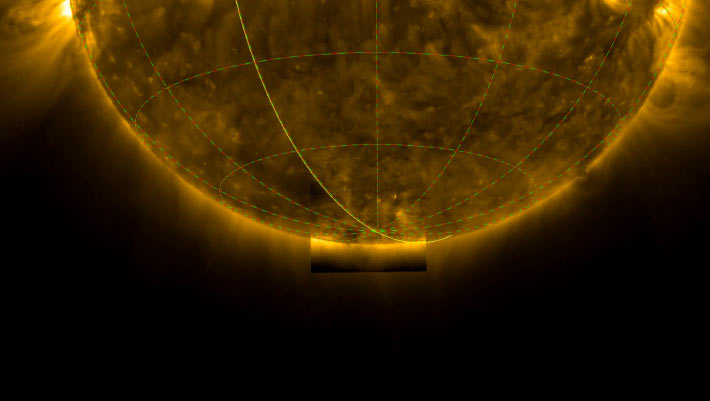Any image we have ever seen of the Sun was taken from around the Sun’s equator. This is because Earth, the other planets, and all other operational spacecraft orbit the Sun within a flat disk around the Sun called the ecliptic plane. By tilting its orbit out of this plane, the ESA/ESA Solar Orbiter spacecraft reveals the Sun from a whole new angle.
Photograph of the bottom half of the Sun, with a highlighted square region around the Sun’s south pole. Taken in ultraviolet light, the image shows the hot gas in the Sun’s outer atmosphere, the corona, glowing yellow as it extends outwards in threads and loops from the Sun. Image credit: ESA / NASA / Solar Orbiter / EUI Team / D. Berghmans, ROB.
“Today we reveal humankind’s first-ever views of the Sun’s pole,” said Professor Carole Mundell, ESA’s Director of Science.
“The Sun is our nearest star, giver of life and potential disruptor of modern space and ground power systems, so it is imperative that we understand how it works and learn to predict its behavior.”
“These new unique views from our Solar Orbiter mission are the beginning of a new era of solar science.”
The images were taken by three of Solar Orbiter’s scientific instruments: the Polarimetric and Helioseismic Imager (PHI), the Extreme Ultraviolet Imager (EUI), and the Spectral Imaging of the Coronal Environment (SPICE) instrument.
“We didn’t know what exactly to expect from these first observations — the Sun’s poles are literally terra incognita,” said Professor Sami Solanki, who leads the PHI instrument team from the Max Planck Institute for Solar System Research.
This collage above shows the Sun’s south pole as recorded on March 16-17, 2025, when Solar Orbiter was viewing the Sun from an angle of 15° below the solar equator. This was the mission’s first high-angle observation campaign, a few days before reaching its current maximum viewing angle of 17°. Image credit: ESA / NASA / Solar Orbiter / PHI / EUI / SPICE Teams.
Solar Orbiter’s instruments each observe the Sun in a different way.
PHI images the Sun in visible light (top left) and maps the Sun’s surface magnetic field (top center).
EUI images the Sun in ultraviolet light (top right), revealing the million-degree charged gas in the Sun’s outer atmosphere, the corona.
The SPICE instrument (bottom row) captures light coming from different temperatures of charged gas above the Sun’s surface, thereby revealing different layers of the Sun’s atmosphere.
By comparing and analyzing the complementary observations made by these three imaging instruments, we can learn about how material moves in the Sun’s outer layers.
This may reveal unexpected patterns, such as polar vortices (swirling gas) similar to those seen around the poles of Venus and Saturn.
These groundbreaking new observations are also key to understanding the Sun’s magnetic field and why it flips roughly every 11 years, coinciding with a peak in solar activity.
Current models and predictions of the 11-year solar cycle fall short of being able to predict exactly when and how powerfully the Sun will reach its most active state.
One of the first scientific findings from Solar Orbiter’s polar observations is the discovery that at the south pole, the Sun’s magnetic field is currently a mess.
While a normal magnet has a clear north and south pole, the PHI instrument’s magnetic field measurements show that both north and south polarity magnetic fields are present at the Sun’s south pole.
This happens only for a short time during each solar cycle, at solar maximum, when the Sun’s magnetic field flips and is at its most active.
After the field flip, a single polarity should slowly build up and take over at the Sun’s poles.
In 5-6 years from now, the Sun will reach its next solar minimum, during which its magnetic field is at its most orderly and the Sun displays its lowest levels of activity.
“How exactly this build-up occurs is still not fully understood, so Solar Orbiter has reached high latitudes at just the right time to follow the whole process from its unique and advantageous perspective,” Professor Solanki said.
PHI’s view of the full Sun’s magnetic field puts these measurements in context.
The darker the color (red/blue), the stronger the magnetic field is along the line of sight from Solar Orbiter to the Sun.
The strongest magnetic fields are found in two bands either side of the Sun’s equator.
The dark red and dark blue regions highlight active regions, where magnetic field gets concentrated in sunspots on the Sun’s surface (photosphere).
Meanwhile, both the Sun’s south and north poles are speckled with red and blue patches.
This demonstrates that at small scales, the Sun’s magnetic field has a complex and ever-changing structure.
Another interesting ‘first’ for Solar Orbiter comes from the SPICE instrument.
Being an imaging spectrograph, SPICE measures the light (spectral lines) sent out by specific chemical elements — among which hydrogen, carbon, oxygen, neon and magnesium — at known temperatures.
For the last five years, SPICE has used this to reveal what happens in different layers above the Sun’s surface.
Now for the first time, the SPICE team has also managed to use precise tracking of spectral lines to measure how fast clumps of solar material are moving.
This is known as a ‘Doppler measurement’, named after the same effect that makes passing ambulance sirens change pitch as they drive by.
The resulting velocity map reveals how solar material moves within a specific layer of the Sun.
“Doppler measurements of solar wind setting off from the Sun by current and past space missions have been hampered by the grazing view of the solar poles,” said SPICE team leader Dr. Frédéric Auchère, a researcher at the University of Paris-Saclay.
“Measurements from high latitudes, now possible with Solar Orbiter, will be a revolution in solar physics.”
https://www.sci.news/astronomy/solar-orbiter-images-suns-poles-13983.html





